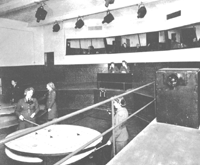| By
June 1940, the Axis powers controlled most of Europe. Poland,
Austria, Holland Belgium, and Norway had all been overrun. When
the British Expeditionary Force was evacuated from Dunkirk (Operation
Dynamo: 27th May - 3rd June) the way was clear for the annexation
of France. Ten days later Paris was occupied. The way seemed
clear for the Germans to turn their attentions to the invasion
of Britain.
Hitler
realized that before a successful sea borne invasion could
be launched, it was essential that the Luftwaffe gained total
control of the skies (Operation Eagle) and that the RAF had
to be neutralized. He ordered the total destruction of the
RAF and placed Reichsmarschall Goering in charge of the operation.
Raids began in earnest on 18th June. The loss of France had
meant that the Luftwaffe could begin replenishment of men
and machines and use their newly acquired French bases to
plan the destruction of the RAF. During that summer CHL (and
CH) were the only systems that were available to 'home' the
fighters onto their targets. Ground Control Interception stations
evolved from the CHL
stations. It was primarily C.J.Banwell, a New Zealander who
developed a new transmitter switch that allowed sufficient
suppression of the transmitter pulse that a single aerial
could now be employed for both transmission and receiving.
This new single aerial could subsequently be continuously
rotated. Finally, if the trace could be made to commence from
the centre of the screen instead of at the left hand edge,
a continuous rotating 360-degree scan could (in theory) be
produced. This work continued through the summer and into
the autumn. By December, three GCI
installations were completed (albeit hastily) at Durrington,
Sopley and Sturminster Marshall. A further 12 mobile units
were ordered by the RAF for immediate use. Thus by the spring
of 1941 GCI was an operational reality.
|

